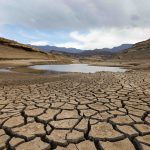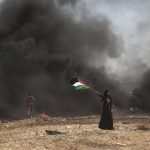The day Gaza becomes uninhabitable
Palestinian-South African academic Haidar Eid speaks to New Frame about the day the United Nations said the densely populated Gaza Strip would officially become unsuitable for human habitation.
Author:
13 January 2020

In 2012, the United Nations published research suggesting that by 2016, the main aquifer supplying water to about two million Palestinian residents of the Gaza Strip would be “unusable” and that by 2020, the aquifer would have been damaged irreversibly. This would make Gaza uninhabitable by 2020.
So for many Gazan residents, the end of the past decade was no time to celebrate. Instead, it was a countdown to the day they would no longer be able to survive.
Israel occupied Gaza in 1967 and it has been under an internationally unlawful military occupation since then. It is a tiny strip of land on the Mediterranean Sea, measuring just 365km2. It is also the most densely populated place on the planet. Gaza’s more than one million residents are refugees from the towns and cities in Palestine that Israel occupied and purged in 1948, when it became a state.
For decades following the 1967 occupation of Gaza, a row of Israeli settlements built along the Gaza coastline ensured that Palestinians were denied access to the sea, even though they lived just 2km from it. Israel finally pulled out of Gaza in 2005, but two years later, when Hamas won the Palestinian Authority elections in Gaza, Israel imposed a siege on the strip that has been in place since then. The area is surrounded by a heavily fortified fence, checkpoint and a border with Egypt that is nearly always closed. More than a million people in Gaza now live on less than R50 a day.
‘Deadly medieval blockade’
Palestinian-South African academic Haidar Eid taught English literature at the former Vista university’s Soweto campus in the late 1990s and was awarded his doctorate by the University of Johannesburg. He is now an associate professor in English literature at Al-Aqsa University in Gaza, a musician and the leading Gaza campaigner for the boycott, divestment and sanctions (BDS) movement against Israel.
“Apartheid Israel has maintained a deadly medieval blockade on Gaza since 2007, when Hamas seized control of the tiny strip after legitimately winning the 2006 Palestinian Authority Legislative Council elections,” said Eid. “The UN made it absolutely clear that in 2020 Gaza would become uninhabitable. We are already there.”
In 2012, the United Nations report said Gaza’s water supply had already reached crisis levels because its aquifer (the only source of water for Gaza) had become so depleted that it was filling up with sea water. The situation is much worse now, with 97% of Gaza’s water undrinkable, according to Eid.
“Most of us don’t drink tap water because of its poor quality. Instead, we buy expensive water from private enterprises at six times the standard rate. Many of us resort to private wells. In fact, we dig wells and get unfiltered water for bathing and washing,” he said.
Related article:
Drought experts in South Africa have warned against the overuse of groundwater during periods of drought; if too many boreholes are sunk too close to the coast, there is a risk of the water table emptying out and sea water seeping in, contaminating the remaining fresh underground water. But unlike South Africa, which has a number of alternative options, such as desalination or wastewater treatment, Gaza has missed out on all innovation.
Israel describes itself as a “world leader” in desalination technology and most of its water comes from four large desalination plants. It also supplies portable desalination jeeps to the Indian army, which desalinate water while driving. But Israel has withheld this technology from Gaza. The Israeli blockade, or siege, of Gaza means the Palestinian Authority cannot set up its own desalination plants as Israel has simply banned it from importing any new technologies, says Eid. Additionaly, Israel will not allow the Palestinian Authority in the West Bank to supply Gaza with water. This leaves Gaza without any option other than to overuse its aquifer.
Lack of power
There are also electricity shortages in Gaza. It has a single power grid that, even before Israel bombed it repeatedly, only supplied Gaza with 40% of its electricity.
“The rest was supposed to be provided by the occupying power, Israel. But it has allowed only 40 watts of power to be provided to the Strip, in the full knowledge that 400 watts are needed for Gaza to meet the bare minimum survival needs,” said Eid.
Residents living in Gaza’s blocks of flats barely get water at all because the generators that pump the water to the upper levels of these high-rise buildings “only work for a few hours a day. Even wells can’t be fully operated. The electricity shortage also prevents the Strip’s sewage treatment plants from operating, allowing untreated sewage water to flow directly into the sea,” said Eid. In 2012, the UN estimated that 90 000m³ of sewage a day was being discharged into the Mediterranean Sea.
“Cutting electricity is a death sentence for the almost two million Gazans living in the Israeli-blockaded strip,” said Eid.
Related article:
Eid said Palestinians in Gaza live a “terrifying existence”, not only because of regular bombings by Israel. The most recent high-profile bombing came in November 2019, when Israel bombed the home of the Sawarka family four times, killing five children and four adults. On Christmas Day, Israel admitted that it had made a “mistake” in doing so.
“The terror of it is that Gazans die every day from preventable illnesses as a result of dirty water or the lack of a life-saving operation, or starvation due to the crops that fail to grow without sufficient irrigation, or babies dying because they cannot be kept warm in their first few days of life,” Eid said.
“Medical conditions due to injuries from internationally prohibited butterfly bullets and other illegal Israeli weapons, as well as from water contamination, cannot be treated because of the siege. In addition to the ban on building materials, Israel also prevents many other necessities from being imported: light bulbs, candles, matches, books, refrigerators, shoes, clothing, mattresses, sheets, blankets, tea, coffee, sausages, flour, cows, pasta, cigarettes, fuel, pencils, pens, paper and many other things. In Gaza, people are wondering whether the current Israeli government, the most fascist in the county’s history, might even discuss a ban on oxygen!”
‘Incremental genocide’
Ilan Pappé, an Israeli academic who teaches at the University of Exeter in the United Kingdom, has described Israel’s policy towards Gaza as one of “incremental genocide”.
According to Eid, the BDS movement is crucial to helping the Palestinians defeat the Israeli military occupation. In late December, British Prime Minister Boris Johnson tabled a draft law aimed at undermining BDS that would “ban” local British councils from “imposing their own direct or indirect boycotts, disinvestment or sanctions campaigns” on Israel or any other country.
Eid said this is indicative of the power of BDS. “South Africans will recall when then British prime minister Margaret Thatcher decided to ban local British councils from boycotts against the apartheid system. And now you have Johnson planning to make a similar decision. In the 1980s, the whole world stood up against the apartheid system and its allies. The same thing is happening now against apartheid Israel.
“It is our South African moment,” he said.


